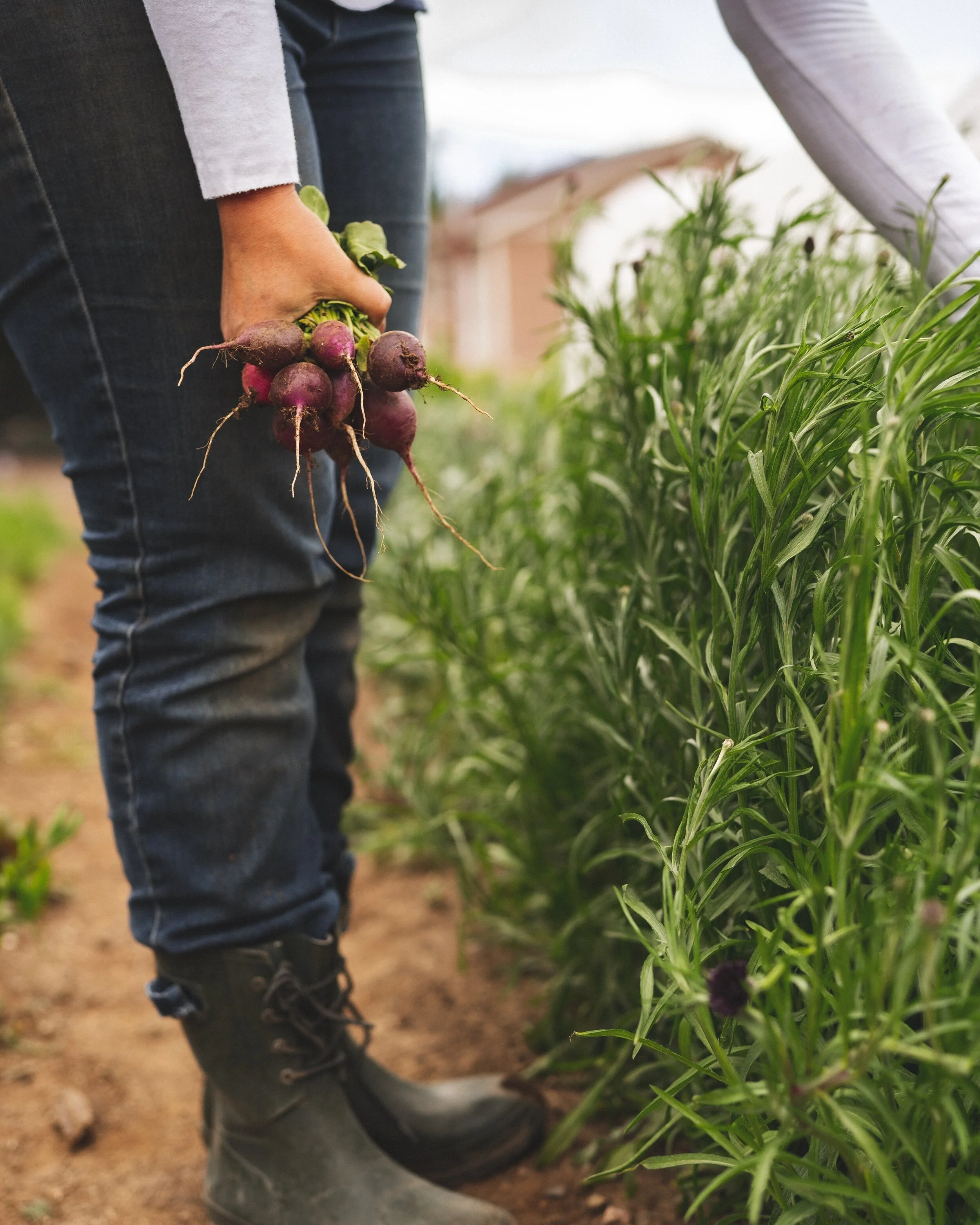The Why and How of Crop Rotation: Long-Term Planning for Flower Farmers
Crop rotation is one of the most powerful tools flower farmers have for maintaining healthy soil and maximizing productivity over the long term. By strategically changing the crops planted in each bed from season to season or year to year, you can:
Improve soil health
Reduce pest and disease pressure
Keep your farm blooming bountifully
In this blog, we’ll explore the strategy behind crop rotation and how it applies specifically to flower farming. From understanding nutrient cycling to creating multi-year rotation plans, you’ll learn how to design a system that balances production with sustainability. Whether managing a few raised beds or a sprawling field, this guide will help you make the most of your growing space year after year.
Ready to dive deeper into the world of crop rotation? Let’s get started.
Note: This post contains affiliate links. If you make a purchase through these links, I may earn a small commission at no additional cost to you. Thank you for supporting our farm!
What Is Crop Rotation and Why Does It Matter?
At its core, crop rotation is the practice of growing different types of crops in the same area across successive seasons or years. This simple yet powerful technique is a cornerstone of sustainable farming, and for flower farmers, it can significantly improve soil health and overall productivity.
Key Benefits of Crop Rotation
Crop rotation is more than just moving plants around—it’s a strategic practice that improves soil health, reduces pest and disease pressure, and maximizes nutrient use. Here’s how crop rotation benefits your flower farm:
1. Soil Health
Different crops use and replenish nutrients at varying rates. Rotating crops helps maintain a healthy balance, reducing the need for synthetic fertilizers.
Nitrogen Fixation: Cover crops like clover or vetch replenish essential nutrients after heavy-feeding flowers like sweet peas.
Salt Management: Grasses or lettuce can heal soil with salt build-up.
Example: We discovered this firsthand when salty patches in our soil caused a crop failure for snapdragons. Rotating with grasses helped remove salts and restore soil health.
2. Pest and Disease Management
Rotating crops disrupts the cycles of pests and diseases that tend to build up when the same crop or plant family is grown repeatedly in one area. This is especially important in tunnels, where airflow and diversity are more limited.
Examples of Common Issues and Rotations to Combat Them:
Fusarium in tulips.
Powdery mildew in zinnias.
Aphids on ranunculus.
Chomping caterpillars attacking snapdragons.
By rotating crops, you reduce the likelihood of these recurring problems and encourage a healthier growing environment.
3. Nutrient Cycling
Crops access nutrients at different depths depending on their root systems. Alternating shallow and deep-rooted plants ensures balanced nutrient use and prevents stratification.
How It Works:
Shallow-Rooted Crops:
Examples: Lisianthus, violas, ranunculus, and snapdragons.
Benefit: These crops pull nutrients from the topsoil and are ideal for planting after deep-rooted crops that have accessed lower soil nutrients.
Deep-Rooted Crops:
Examples: Branching sunflowers, amaranth, cosmos, and ammi.
Benefit: These plants break up compacted soil, access buried minerals, and enrich the soil when decomposed.
Pro Tip: Pairing Shallow and Deep-Rooted Plants
Maximize bed use by pairing crops with complementary root systems:
Violas and Peonies: Shallow-rooted violas thrive beneath deep-rooted perennials like peonies.
Frosted Explosion Grass and Branching Sunflowers: Combining these ensures they don’t compete for the same nutrients, optimizing the bed’s productivity.
Real-World Application Example
On our farm, we’ve found that alternating shallow and deep-rooted crops improves soil health over time. For example:
Rotation: After growing branching sunflowers in a bed, we rotate to shallow-rooted crops like ranunculus or snapdragons the following season. This ensures the topsoil nutrients are fully utilized while allowing the bed to recover deeper down.
Interplanting: Similarly, pairing frosted explosion grass with sunflowers maximizes productivity without competition for nutrients. Since frosted explosion grass is shallow-rooted, it thrives in the same bed as deep-rooted sunflowers, taking advantage of the shade while requiring minimal water or nutrients.
4. Better Productivity Over Time
Healthy soil leads to stronger, more productive plants. By incorporating crop rotation into your planning, you’ll see improved yields season after season.
Long-Term Crop Rotation Strategies for Flower Farms
While crop rotation is often thought of season by season, planning rotations over several years can provide even greater benefits. For flower farmers, this means balancing production goals with long-term soil health and sustainability.
Rotating by Plant Families
Many flowers belong to specific plant families, and grouping these families in your rotation plan helps manage nutrient use and pest cycles.
Example Plant Family Rotations:
Bulbs (e.g., tulips, narcissi): Narcissi are often perennialized, but you can interplant shallow-rooted varieties like celosia over them to make better use of the space. Narcissi also provide the added benefit of erosion control in sloped areas.
Asters (e.g., sunflowers, dahlias): Follow with cover crops or grasses to replenish the soil.
Amaranths (e.g., celosia, amaranth): Alternate with nitrogen-fixing crops like clover.
Pro Tip: Avoid planting members of the same plant family back-to-back in the same bed to minimize the risk of pests and diseases. For instance, avoid planting ornamental cabbage in a bed that just grew stock, as both belong to the brassica family and share similar pest and disease pressures.
Multi-Year Rotations: Building Healthier Soil for Long-Term Success
Multi-year rotations are especially valuable when preparing beds for perennials or biennials or when heavily used soil needs extra love and recovery time. By planning rotations across several years, you can balance productivity with sustainability while building healthier soil.
Example Multi-Year Plan for Long-Term Soil Health
Year 1: Cover Crops
Begin by planting nitrogen-fixing cover crops like clover or vetch, or soil-conditioning crops like winter rye or mustard. These crops build organic matter, suppress weeds, and replenish soil nutrients.
Year 2: Annuals
After terminating the cover crop, plant fast-growing annuals like zinnias, cosmos, or sunflowers. These crops thrive in the enriched soil and allow you to maximize production.
Year 3: Prep for Perennials or Biennials
Rotate the bed into lighter feeders like ammi or ornamental grasses. These plants continue to produce while giving the soil a lighter workload. This is also an ideal year to add compost or amendments and prepare the soil for more permanent plantings.
If you notice troublesome signs of poor soil health, consider planting a fast-growing cover crop, such as buckwheat, before introducing a cash crop. This quick fix can rejuvenate the soil and set the stage for better growth.
Year 4+: Establish Perennials or Biennials
Plant long-term crops like peonies, hydrangeas, or foxglove. After years of preparation, the soil is nutrient-rich and balanced, supporting the needs of these heavy or continuous feeders.
Don’t forget to topdress the soil with compost in the fall or spring to replenish nutrients and maintain soil health for the years ahead.
Why Use a Multi-Year Approach?
Soil Recovery: Rotating from high-demand annuals to lower-impact crops ensures soil health.
Sustainable Productivity: Perennials thrive in well-prepared soil, rewarding early efforts with long-term harvests.
Pest and Disease Management: Alternating crop families disrupt cycles and reduce pressure over time.
Pro Tip: Don’t rush perennial plantings. Allow time for your soil to recover and build fertility, ensuring healthier plants and better yields.
Working Around Perennials
For flower farmers who grow perennials like peonies or hydrangeas, rotations can feel tricky. Instead of moving the plants, rotate the crops grown in neighboring rows to maintain soil health and balance nutrient use in the area.
If pest or disease pressure becomes an issue, consider interplanting low-impact companion plants. For example:
French Marigolds: Naturally deter nematodes and certain soil pests while staying compact.
Chamomile: Suppresses fungal diseases, attracts pollinators, and offers a light, airy growth habit that won’t compete with peonies.
Thyme or Oregano: Compact, perennial herbs that deter pests like whiteflies and fit neatly around peonies without becoming invasive.
Example: If peonies occupy a fixed row, rotate cover crops, annuals, and grasses in adjacent beds. Meanwhile, interplant companion plants like marigolds, chamomile, or thyme among the peonies to promote a healthier ecosystem without crowding or competition.
For Other Perennial Crops: Companion Planting Opportunities Expand
Perennials like lilacs, woody shrubs, or even ornamental grasses allow for more companion planting flexibility. These plants typically tolerate companions with more vigorous growth habits:
Mint: Repels aphids, whiteflies, and ants while thriving near woody shrubs like lilacs or roses. (Be sure to contain its spread!)
Basil: Repels pests like mosquitoes and aphids; a great companion for roses or woodies in warmer climates.
Lemon Balm: Attracts pollinators and deters pests, working well in shrub beds.
Bee Balm (Monarda): Draws pollinators and supports biodiversity in mixed perennial plantings.
Comfrey: Excellent for improving soil health and providing mulch material; pairs well with woodies where spreading isn’t an issue.
Example: For lilacs or other woody shrubs, mint or comfrey can be interplanted to provide pest control and soil benefits. With roses, alyssum or violas can enhance pollinator attraction while providing secondary harvests for florals or culinary use.
Incorporating Cover Crops: Building Healthier Soil for Sustainable Flower Farming
Cover crops, often called “green manure,” can be a valuable component of sustainable crop rotation. While we’ve successfully built our soil health through crop rotation, homemade compost, and biodiversity, cover crops offer another tool to improve soil structure, prevent erosion, and reduce the need for synthetic inputs—all while keeping your beds healthy during the off-season.
Benefits of Cover Crops for Flower Farmers
Cover crops do more than just fill space; they actively work to regenerate your soil. Key benefits include:
Soil Health Improvement: Cover crops like clover and vetch fix nitrogen in the soil, replenishing nutrients used by heavy feeders like sweet peas and zinnias.
Erosion Control: Grasses like rye or oats are excellent for stabilizing sloped areas and preventing soil loss during heavy rains.
Weed Suppression: Fast-growing cover crops outcompete weeds, reducing labor-intensive weeding in the next season.
Biofumigation: Certain cover crops, like mustard, help combat soil-borne pests such as nematodes while suppressing disease pressure.
Organic Matter Addition: When tilled under or left to decompose, cover crops add valuable organic matter, boosting soil structure and water retention.
Timing Your Cover Crops
The key to successful cover cropping is planning around your growing schedule. To make the most of cover crops, consider reserving a portion of your planting space specifically for soil-building crops throughout the season.
How to Time Your Cover Crops:
Fall Planting:
After pulling summer annuals like zinnias or sunflowers, sow cover crops like winter rye, clover, or vetch. These crops will grow over the winter, protecting the soil and replenishing nutrients for the next season.Spring Quick Turn:
Fast-growing crops like buckwheat can be sown and turned under in 30–40 days, making them ideal for filling gaps between spring and summer plantings.Seasonal Rests:
If a bed won’t be used for a full growing season, plant a diverse cover crop mix (e.g., oats and peas) to maximize soil benefits.
Pro Tip: Reserve Rows for Cover Cropping
To incorporate cover crops seamlessly into your rotation, plan to leave a portion of your planting space—such as a quarter of your rows—dedicated to soil-building throughout the season. For example:
Divide your planting space into quarters, with three quarters used for active crop production and one quarter reserved for cover crops or seasonal rests.
Rotate the cover crop quarter each season to ensure all rows receive soil-restoring benefits over time.3. Choosing the Right Cover Crop for Your Rotation
Different cover crops serve different purposes, and some can even double as valuable harvestable crops. Choosing the right one ensures maximum benefits for your soil and farm.
Key Considerations Before Planting a Cover Crop
Start with a Soil Test:
Soil tests can guide your cover crop choices by identifying deficiencies or imbalances. For example:If your soil is nitrogen-rich, avoid nitrogen-fixing crops like clover and focus on organic matter builders like oats.
High salt levels in the soil? Plant grasses like wheat or rye to help alleviate salt build-up.
Avoid the Wrong Match:
Selecting the wrong cover crop for your rotation can cause more harm than good.Example: Mustard is great for nematode suppression but can deplete soil if used repeatedly without adequate replenishment.
Example: A fast-growing cover crop like buckwheat might outcompete slower crops if not terminated in time, delaying your next planting.
Understand Lifecycle Timing:
Some cover crops require months to deliver their full benefits, while others, like buckwheat, are ready in 30 days. Ensure your choice aligns with your crop rotation schedule.
Examples of Dual-Purpose Cover Crops for Flower Farmers
In addition to soil benefits, certain cover crops can double as valuable harvestable crops:
Nitrogen-Fixing Crops: Clover, vetch, or peas replenish soil nutrients.
Dual-Value Option: Pea cover crops offer tendrils or blooms for floral designs.
Quick Turn Crops: Buckwheat grows quickly, suppresses weeds, and attracts pollinators.
Dual-Value Option: Harvest buckwheat flowers as bouquet fillers.
Erosion Control: Annual ryegrass and oats stabilize soil.
Dual-Value Option: Use green wheat or rye for textured stems in arrangements.
Biofumigant Crops: Mustard or radish combat nematodes and soil-borne diseases.
Dual-Value Option: Radish seed pods add ornamental or culinary value, while Red Giant Mustard leaves can serve as striking foliage in edible bouquets, offering a unique and visually stunning option for your customers.
Pro Tip:
Always evaluate your rotation goals when selecting cover crops. A crop chosen for yield might not provide the same soil benefits if harvested, so balance soil health with profitability.
Managing Cover Crops in Your Rotation
Cover crops require thoughtful planning to incorporate them into your crop rotation without disrupting your planting schedule. Here’s how to manage them effectively:
Termination Options:
Mow or Crimp:
Cut cover crops down and leave the residue as mulch to suppress weeds and slowly release nutrients into the soil.Till:
Incorporate the cover crops into the soil for faster decomposition, creating “green manure.” This method works well if you need the bed ready for planting sooner.Use a Silage Tarp:
Cover the bed with a silage tarp for 3–4 weeks to terminate the cover crop without disturbing the soil. This method is especially effective for no-till systems, as it smothers the plants and encourages decomposition while preserving soil structure.
Looking for a high-quality silage tarp? We recommend the durable options from Bootstrap Farmer—a trusted source for farm supplies. Their silage tarps (light-deprivation tarps) are built to last and are perfect for sustainable flower farming.
Timing for Planting:
Wait 2–3 weeks after incorporating cover crops (via tilling or tarping) before planting the next crop. This allows time for decomposition and ensures that the nutrients are available for your plants.
Integrating with Successions:
Cover crops don’t have to fill entire seasons; even a short 30-day growth period can improve soil for the next succession. For example:
Use buckwheat for a quick boost between early spring and summer plantings.
Terminate winter rye in early spring and follow with heat-loving summer crops like zinnias or sunflowers.
Pro Tip: Using a silage tarp can double as weed suppression during the cover crop termination process, giving you a head start on bed preparation while improving soil health.
Pro Tip: Linking to Tools: If you’re tracking rotations in a spreadsheet, include a column for cover crops. Document the type, planting date, and termination method to refine your process year after year.
Example Schedule for Cover Crop Integration:
Early Spring: Pull winter rye and plant a fast cover crop like buckwheat.
Mid-Summer: After harvesting zinnias, sow a short-term clover or mustard crop.
Fall: Following summer annuals, plant winter rye or oats for soil protection over the colder months.
Addressing Challenges and Adapting Your Plan
No matter how carefully you plan, challenges like weather, pests, and limited space can throw a wrench into your crop rotation schedule. Adapting to these challenges ensures that your rotation remains effective while keeping your flower farm productive.
1. Limited Space
Many small-scale flower farmers face the challenge of fitting diverse crops into limited growing areas, I know we have! Here’s how to adapt:
Prioritize High-Yield Crops: Focus your rotations on crops that provide maximum output per square foot, like dahlias or zinnias, and rotate lighter feeders like grasses or statice afterward.
Interplant Strategically: Pair crops with different growth habits in the same space. For example, shallow-rooted celosia can be interplanted over perennial narcissi to maximize bed use.
Use Vertical Space: Incorporate trellises for crops like sweet peas, which free up ground space for rotations below.
2. Overlapping Seasons
Succession planting and crop rotations can sometimes overlap, especially when early crops linger past their expected harvest dates.
Tight Transitioning: Plan for fast-growing cover crops like buckwheat or oats to fill gaps between successions.
Cut Back, Don’t Clear: For late-season crops, consider cutting back the plants but leaving roots in the ground until the next crop is ready to be planted. This practice feeds soil microbes while maintaining flexibility.
3. Unpredictable Weather
Unexpected weather can delay planting or force an early harvest, disrupting your carefully planned schedule.
Keep Back-Up Options: Always have extra seedlings or seeds ready to replace crops lost to frost, hail, or heatwaves.
Flexible Cover Crops: Choose cover crops that can be sown quickly and terminated easily to accommodate sudden changes.
Focus on Resilient and Fast-Growing Varieties: Incorporate hardy crops like bachelor buttons, ammi, or calendula that can handle diverse conditions.
4. Pest and Disease Pressure
Even with rotation, pest and disease outbreaks can happen, forcing you to adapt your plan.
Remove Problem Crops Early: If pests or diseases are present, pull infected crops immediately and replace with resistant or fast-turn crops like sunflowers.
Interplant Companions: Use companion planting to support your rotation plan. For example, interplant marigolds to deter nematodes or nasturtiums to attract aphids away from main crops.
Utilize Green Manures: Crops like mustard or radish can act as biofumigants or aerators to suppress soil-borne diseases and compacted soil before planting your next rotation.
Pro Tip: Adapting your plan doesn’t mean starting over. Use your notes and records to refine your approach for the next season, and don’t hesitate to incorporate lessons learned into your crop rotation strategy. A plan is a starting point, the experience will refine it.
Bringing It All Together: Creating a Resilient Crop Rotation Plan
By now, you’ve seen how crop rotation is much more than simply moving crops around—it’s a strategic practice that combines long-term planning, adaptability, and sustainability. Here’s how to integrate everything you’ve learned into a practical, effective crop rotation plan:
1. Step Back and Look at the Big Picture
Think about your farm as a whole, considering:
Your Goals: Are you prioritizing yields, soil health, or both?
Check out our Deciding on a Product Blog to align your goals with what you grow.Your Space: Identify which beds can accommodate rotation, cover crops, or perennials.
Learn how we maximize production with limited space in our Maximizing Production Blog.Your Timeline: Plan for one season, one year, or even a multi-year cycle.
Explore our Goal Setting Blog to map out a long-term strategy tailored to your farm’s needs.Pro Tip: If you haven’t already, map out your space and assign rotations to each bed using tools like our Crop PlanningTemplate.
2. Align Crop Rotations with Your Season
Early Season: Use beds for bulbs or other early crops, followed by nitrogen-fixing cover crops to prepare for summer planting.
Summer Season: Rotate heavy feeders like dahlias or zinnias into beds enriched by cover crops.
Fall Transition: Plant fast-growing fillers, cover crops, or ornamental grasses to extend your productivity while rebuilding soil.
Example Plan:
Spring: Tulips → Summer: Zinnias → Fall: Clover or Rye.
3. Build Flexibility into Your Plan
No plan survives the season perfectly, but flexibility can keep things running smoothly:
Have backup crops like sunflowers or buckwheat that can fill gaps in rotation.
Plan for adjustments due to weather, pests, or unexpected events.
Use tools like your tracking spreadsheet to stay on top of changes and make notes for next season.
4. Connect Rotations to Your Larger Farming Practices
Crop rotation works best when paired with:
Soil Testing: Identify deficiencies and select crops or cover crops to balance nutrients.
Successions: Plan for overlapping or staggered plantings to maximize bed use.
Companion Planting: Introduce companion plants to address pest pressure or nutrient needs alongside rotation.
Pro Tip: Use each season as a learning opportunity. Record what worked, what didn’t, and where you could improve. Over time, your rotations will become even more efficient and productive.
Ready to see crop rotation in action? Don’t miss our Practical Crop Rotation Guide, where we show step-by-step examples of how to rotate your beds for a productive and profitable season.
Planting for Today and Building for Tomorrow
Crop rotation is more than just a method for organizing your beds—it’s a foundation for sustainable flower farming. By thoughtfully planning rotations, incorporating cover crops, and staying adaptable to challenges, you can protect your soil, improve your yields, and create a thriving farm for years to come.
As you implement these practices, remember:
Start small if needed, testing rotations in a few beds to see what works best for your soil and space.
Use tools like our Crop Planning Template to map out your rotations and keep track of what’s been planted.
Don’t be afraid to experiment—every season brings lessons that can refine your approach.
Ready to take the next step? Dive into our Practical Crop Rotation Guide for real-world examples of rotating your growing beds effectively during the growing season, or explore our Maximizing Production Blog to get the most out of your space.
Your farm’s health and productivity start with the choices you make today—so plan wisely, rotate thoughtfully, and grow abundantly. Happy Planning!
We are looking forward to sharing more blooms with you soon.
Jessica & Graham











